Daylilies (Hemerocallis) are beloved flowering perennials known for their stunning blooms, versatility, and easy-care nature. These plants are cherished by gardeners worldwide for their prolific flowering, vibrant colors, and adaptability to various growing conditions.
Originating from East Asia, daylily have been cultivated for centuries and have earned their popularity due to their reliability and low-maintenance requirements. Unlike true lilies (genus Lilium), which belong to the Liliaceae family, daylilies belong to the Hemerocallidaceae family and are not true lilies.
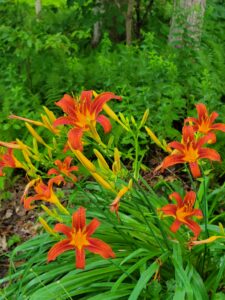
The name “daylily” reflects the ephemeral nature of the flowers, with each bloom lasting only a day before wilting. However, daylily plants produce numerous flower buds on each stalk, resulting in an extended blooming period that typically lasts several weeks to months, depending on the variety.
Daylilies are prized for their diverse range of flower forms, colors, and sizes. Flowers can be trumpet-shaped, spider-like, ruffled, or double-petaled, and they come in an array of hues, including yellow, orange, red, pink, purple, and near-white. Some cultivars even feature bi-colored or patterned blooms.
In addition to their ornamental value, daylilies are valued for their versatility in the garden. They are excellent for mass plantings, borders, or mixed perennial beds, where they provide bursts of color and texture throughout the growing season. Daylilies also perform well in containers and are suitable for both formal and informal garden settings.
Beyond their aesthetic appeal, daylilies are prized for their adaptability and low maintenance requirements. They thrive in a wide range of climates and soil types, although they prefer well-draining soil and full sun to partial shade. Once established, daylilies are drought-tolerant and relatively pest and disease-resistant, making them an ideal choice for beginner gardeners or anyone seeking reliable, long-lasting beauty in the garden.
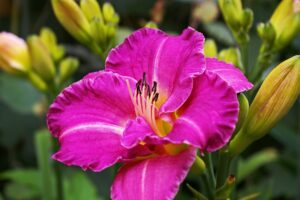
With their stunning blooms, easy-care nature, and versatility, daylilies are a must-have addition to any garden, adding beauty and charm wherever they are planted. Whether used as a focal point, border plant, or mass planting, daylilies never fail to impress with their vibrant colors and abundant blooms.
Sunlight Requirement of Daylilies
Daylilies thrive in full sun to partial shade. Ideally, they should receive at least six hours of direct sunlight daily to produce the best blooms. However, they can also tolerate some shade, especially in hotter climates where they may benefit from protection during the hottest part of the day. In regions with intense afternoon sun and high temperatures, providing afternoon shade can help prevent stress and prolong the blooming period.
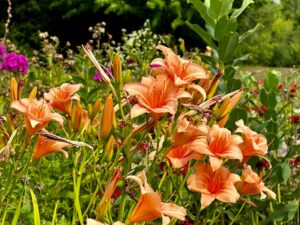
Temperature and Humidity Requirement of Daylilies
Daylilies are generally quite adaptable to a wide range of temperatures and humidity levels. They thrive in temperate to warm climates and can withstand both heat and cold to some extent. Daylilies grow well in temperatures ranging from 60°F to 90°F (15°C to 32°C). They are relatively tolerant of fluctuations in temperature, making them suitable for various climates. However, they may become stressed during periods of extreme heat or cold, so providing adequate moisture and protection during such times can help maintain their health.
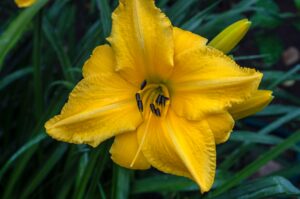
While daylilies can tolerate different humidity levels, they typically prefer moderate humidity. They can withstand relatively dry conditions but may benefit from occasional watering during dry spells, especially in regions with low humidity.
Soil Requirement of Daylily
Daylilies thrive in well-draining soil that is rich in organic matter. Daylilies grow best in soil with a slightly acidic to neutral pH range of 6.0 to 7.0. Sandy loam or loamy soil types are ideal for promoting good drainage. Daylily prefer soil that drains well to prevent waterlogging, which can lead to root rot.
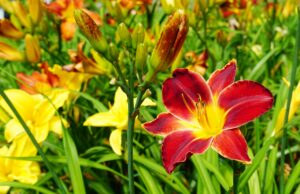
Propagation of Daylilies
Daylily can be propagated through division or seeds. Here’s how you can propagate daylilies using these methods:
Division
Divide daylilies in spring or early fall when they are not actively blooming.
Dig up the clump of daylilies you want to divide, ensuring you don’t damage the roots.
Shake off excess soil to expose the roots and individual fans (clusters of leaves).
Use a sharp knife or garden spade to divide the clump into smaller sections. Each division should have several fans and a portion of the root system.
Replant the divisions immediately in prepared soil, ensuring the crown (where the foliage meets the roots) is at or slightly above soil level.
Seeds
Allow spent flowers to develop seed pods. Collect the pods once they turn brown and dry.
Crack open the pods to extract the seeds.
Sow the seeds in a seed-starting mix indoors in late winter or early spring, or directly outdoors after the last frost date.
Keep the soil consistently moist and provide warmth and light for germination.
Transplant seedlings outdoors once they develop several sets of true leaves.
Propagation through division is the most common method for home gardeners as it ensures that the new plants maintain the characteristics of the parent plant.
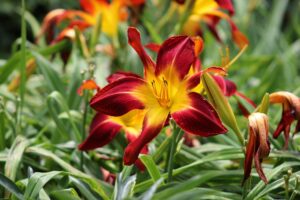
Water Requirement of Daylily
Daylilies have moderate water requirements and are generally considered drought-tolerant once established. Water newly planted daylilies regularly to help them establish their root systems. Keep the soil consistently moist but not waterlogged for the first few weeks after planting. Water deeply to encourage deep root growth. Shallow, frequent watering can result in shallow roots. Once daylily are established (usually after the first growing season), they are more tolerant of dry conditions.
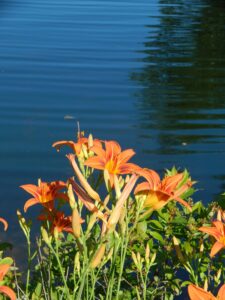
Fertilizer Requirement of Daylily
Daylilies are relatively low-maintenance plants when it comes to fertilizing, but they benefit from some nutritional supplementation to support healthy growth and prolific blooming. Apply fertilizer to daylilies in early spring, just as new growth begins to emerge from the ground. You can also apply a second round of fertilizer after the first flush of blooms has finished, typically in midsummer, to encourage continued flowering. Use a balanced, slow-release fertilizer formulated for flowering plants or a specifically labeled daylily fertilizer.
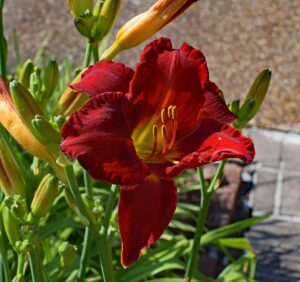
If growing daylilies in containers, they may require more frequent fertilization due to the limited nutrient supply in the potting mix. Apply a balanced liquid fertilizer diluted to half strength every 4-6 weeks during the growing season.
Cultivars of Daylilies
Daylilies are prized for their wide range of cultivars, offering a variety of flower colors, shapes, sizes, and bloom times. Here are some popular cultivars of daylilies:
Stella de Oro: One of the most popular daylilies, known for its prolific blooming habit and golden-yellow flowers. It has a compact growth habit and blooms continuously throughout the summer.
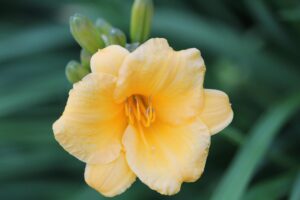
Pardon Me: This cultivar features stunning cranberry-red flowers with a small yellow-green throat. It blooms profusely in midsummer and reblooms later in the season.
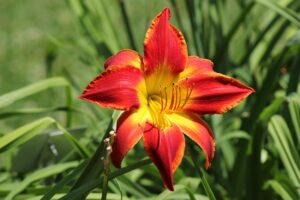
Hyperion: A classic daylily with large, fragrant, lemon-yellow flowers that bloom in midsummer. It has tall scapes and a vigorous growth habit, making it a standout in the garden.
Purple de Oro: A compact daylily with striking purple flowers and a yellow-green throat. It blooms profusely and reblooms throughout the summer, adding a splash of vibrant color to the garden.
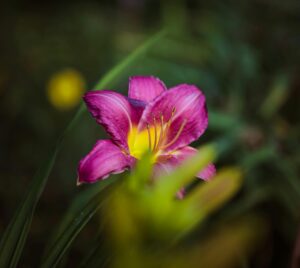
Chicago Apache: Known for its bold, red flowers with a contrasting yellow throat. This cultivar has a tall growth habit and blooms in midsummer, attracting attention with its striking coloration.
Kwanso: Double-flowered daylily with ruffled, orange-gold blooms. It has a vigorous growth habit and blooms abundantly in midsummer, adding a touch of old-fashioned charm to the garden.
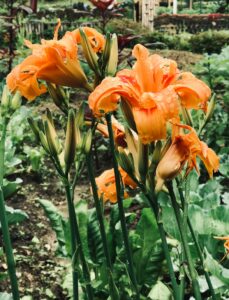
Rocket City: This cultivar features large, tangerine-orange flowers with a contrasting burgundy eyezone. It blooms profusely in midsummer and reblooms later in the season, attracting butterflies and hummingbirds.
Frans Hals: Striking bi-colored daylily with orange-red petals and yellow edges. It blooms in midsummer and has a compact growth habit, making it suitable for borders and rock gardens.
Hush Little Baby: Dwarf daylily with pale lavender-pink flowers and a green throat. It blooms profusely in midsummer and is perfect for edging containers, or mass plantings.
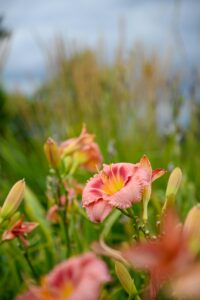
Bonanza: Compact daylily with bright gold flowers and a small green throat. It blooms profusely in early to midsummer, adding a cheerful pop of color to the garden.
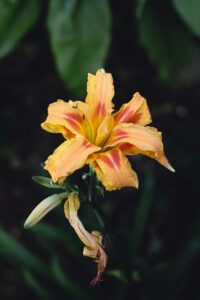
Joan Senior: Large-flowered daylily with creamy-white petals and a green throat. It blooms in midsummer and has a tall growth habit, making it an excellent choice for borders or focal points.
These are just a few examples of the many cultivars available, each offering its unique characteristics and beauty. Whether you prefer vibrant colors, delicate pastels, or striking bi-colors, there’s a daylily cultivar to suit every taste and garden style.


